
After this long, hot summer, the first of the fall rains has finally come to green things back up again. It was a historically hot summer, perhaps the hottest we have ever seen on record and with it came a lot of concerns from local farmers about how to keep crop production up in the face of worsening drought conditions. Irrigated agriculture consumes the largest portion of the United States water resources. It is estimated that globally over 2 quadrillion gallons of water are used in agricultural production annually. That is a really, really big number, so big in fact It’s hard to wrap your head around it. A quadrillion is a million billion. It sounds silly to even say that but if you can really appreciate how big of a number a billion is and then times it by a million, that’s the amount we are talking about here. Of that 2 Quadrillion gallons that is used every year around the globe about 40% of it is lost to the environment, either through inefficient irrigation systems, evaporation or poor water management.
The Marion SWCD has been working in part to conserve our precious water resources. Through our LAP program we provide farmers with the tools to better use water and maximize efficiency. I totaled up the estimated water savings from just the 12 LAP irrigation improvement projects that cooperators are working on now and the gallons of water saved through these efforts came to a total of 98,540,995. That’s almost one hundred million gallons of water saved just from projects that are being implemented right now. One such project to put water savings on the ground is converting big gun traveler systems that put out huge volumes of water that can be lost to wind drift and cause erosion on the soil they hit, over to drip systems. This has been especially successful on crops such as Caneberries and Hazelnuts in the valley. We have several linear projects under construction right now as well. These large travelling overhead irrigation systems can utilize low flow nozzle systems and travel at operator set speeds across a field to deliver the precise amount of water needed while avoiding runoff and droplet caused erosion.
I recently got to tour the brand-new AG Sciences and Technology Hub at Chemeketa Community College where this past summer they had a 160’ Single span GPS linear installed for students studying Ag Sciences. The system was donated to the college by Valley irrigation. It is going to be used to irrigate ½ acre of organic vegetable and fruit production as well as woody ornamentals lab that will demonstrate growing tree’s in bare root and balled and burlapped production methods. Students working on the 1 year irrigation certificate program that the school offers will get to learn about the newest and most efficient agricultural irrigation systems. It’s good to know that with the changing environment students are learning methods of plant production and irrigation that minimize water usage and hopefully this generation of students who will become the next generation of ag producers will have the knowledge and tools to adapt to the changing climatic conditions we are facing. Down the road hopefully we can save some of that 2 quadrillion gallons of water for future generations to enjoy. In case you want to know what it looks like written out, 2 quadrillion is 2,000,000,000,000,000.
